A New Strategy for Sponge City Construction of Urban Roads: Combining the Traditional Functions with Landscape and Drainage
Abstract
:1. Introduction
2. Materials and Methods
2.1. Project Overview
2.2. Design Scheme
2.3. Sampling and Analytical Methods
3. Results
3.1. Establishment of a New Model of SCCUR
3.2. Pilot Study
3.2.1. Background of the Site
3.2.2. Design of the SC Facilities
3.2.3. Ribbon Biological Retention Zone
3.2.4. Diversion Facilities
3.2.5. Runoff and Pollution Control Capacity
4. Discussion
5. Conclusions
- New design strategy. The construction strategy focused on the organization of runoff rainwater in the road space, which could be achieved through vertical optimization of the structure. Thus, the vertical relationship of different facilities needs to be designed in an integrated way, and the basic functions of the facilities need to be met. While ensuring the drainage safety, the runoff rainwater shall be diverted to the nearest SC facilities with capacity of retention and pollutant removal.
- Additional advantages of the new strategy. Generally, the road and the green space were used to create a sponge road combining basic road functions with landscape effect and drainage capacity. The reconstruction of a road in Zhangjiagang with this new strategy was successful. Through the construction of permeable pavements, biological retention facilities, and other facilities, optimization of runoff organization, volume control of the runoff, removal of pollutants, and renewal of the road were realized. The construction of SC not only can achieve the goal of stormwater management, but also is an important way to realize urban renewal.
Author Contributions
Funding
Acknowledgments
Conflicts of Interest
References
- Zhao, Y.; Xia, J.; Xu, Z.; Zou, L.; Qiao, Y.; Li, P. Impact of urban expansion on rain island effect in Jinan city, north China. Remote Sens. 2021, 13, 2989. [Google Scholar] [CrossRef]
- Risch, E.; Gasperi, J.; Gromaire, M.; Chebbo, G.; Azimi, S.; Rocher, V.; Roux, P.; Rosenbaum, R.K.; Sinfort, C. Impacts from urban water systems on receiving waters -How to account for severe wet-weather events in LCA? Water Res. 2018, 128, 412–423. [Google Scholar] [CrossRef]
- Beg, M.N.A.; Rubinato, M.; Carvalho, R.; Shucksmith, J. CFD Modelling of the transport of soluble pollutants from sewer networks to surface flows during urban flood events. Water 2020, 12, 2514. [Google Scholar] [CrossRef]
- Bae, C.; Lee, D.K. Effects of low-impact development practices for flood events at the catchment scale in a highly developed urban area. Int. J. Disaster Risk Reduct 2020, 44, 101412. [Google Scholar] [CrossRef]
- Rubinato, M.; Nichols, A.; Peng, Y.; Zhang, J.; Lashford, C.; Cai, Y.; Lin, P.; Tait, S. Urban and river flooding: Comparison of flood risk management approaches in the UK and China and an assessment of future knowledge needs. Water Sci. Eng. 2019, 12, 274–283. [Google Scholar] [CrossRef]
- Kuller, M.; Bach, P.M.; Ramirez-Lovering, D.; Deletic, A. Framing water sensitive urban design as part of the urban form: A critical review of tools for best planning practice. Environ. Model. Softw. 2017, 96, 265–282. [Google Scholar] [CrossRef]
- Zha, X.; Luo, P.; Zhu, W.; Wang, S.; Wang, Z. A bibliometric analysis of the research on sponge city: Current situation and future development direction. Ecohydrology 2021, 14, 2328. [Google Scholar] [CrossRef]
- Qi, Y.; Shun Chan, F.K.; Griffiths, J.; Feng, M.; Sang, Y.; O’Donnell, E.; Hutchins, M.; Thadani, D.R.; Li, G.; Shao, M.; et al. Sponge city program (SCP) and urban flood management (UFM)-the case of Guiyang, SW China. Water 2021, 13, 2784. [Google Scholar] [CrossRef]
- Wang, K.; Zhang, L.; Zhang, L.; Cheng, S. Coupling coordination assessment on sponge city construction and its spatial pattern in Henan province, China. Water 2020, 12, 3482. [Google Scholar] [CrossRef]
- Yin, D.; Chen, Y.; Jia, H.; Wang, Q.; Chen, Z.; Xu, C.; Li, Q.; Wang, W.; Yang, Y.; Fu, G.; et al. Sponge city practice in China: A review of construction, assessment, operational and maintenance. J. Clean. Prod. 2021, 280, 124963. [Google Scholar] [CrossRef]
- Hu, D.; Zhang, C.; Ma, B.; Liu, Z.; Yang, X.; Yang, L. The characteristics of rainfall runoff pollution and its driving factors in Northwest semiarid region of China—A case study of Xi’an. Sci. Total Environ. 2020, 726, 138384. [Google Scholar] [CrossRef]
- Code for Planting Planning and Design on Urban Road; Ministry of Construction of the People’s Republic of China: Beijing, China, 1997; p. 4.
- Water Quality-Guidance on Sampling Techniques; Ministry of environmental protection of the people’s Republic of China: Beijing, China, 2009; pp. 1–16.
- Li, J.; Sun, Y.; Li, X.; Wang, W. Research on stormwater runoff quality monitoring in sponge city. Water Wastewater Eng. 2021, 6, 68–74. [Google Scholar]
- Perera, T.; McGree, J.; Egodawatta, P.; Jinadasa, K.B.S.N.; Goonetilleke, A. New conceptualisation of first flush phenomena in urban catchments. J. Environ. Manag. 2021, 281, 111820. [Google Scholar] [CrossRef]
- Analytical Methods for Water and Wastewater Monitoring, 4th ed.; China Environmental Monitoring Press: Beijing, China, 2002; pp. 107–258.
- Technical Guide for Sponge City Construction: Rainwater System Construction for Low Impact Development: Trial Implementation; China Construction Industry Press: Beijing, China, 2015; p. 58.
- Guide for Construction, Operation and Maintenance of Rainwater Garden in Jiangsu Province; Department of Housing and Urban Rural Development of Jiangsu Province: Nanjing, China, 2018; pp. 32–34.
- Wang, N. Discussion on design schemes for urban road reconstruction based on sponge city concept in Xiamen. China Water Wastewater 2016, 22, 112–116. [Google Scholar]
- Gong, M.; Zuo, J.; Ren, X.; Zhao, H.; Luo, X.; Liao, Y.; Li, X. Evaluation on effect of urban non-point source pollution control on porous asphalt-bio-retention combined roads. Environ. Sci. 2018, 9, 4096–4104. [Google Scholar]
- Li, P.; Jia, Y.; Lu, J.; Teng, J.; Zhang, H.; Tao, H. Pollution control for storm runoff water quality on elevated road. China Water Wastewater 2016, 19, 142–146. [Google Scholar]
- Paudel, B.; Montagna, P.A.; Adams, L. The relationship between suspended solids and nutrients with variable hydrologic flow regimes. Reg. Stud. Mar. Sci. 2019, 29, 100657. [Google Scholar] [CrossRef]
- Kayhanian, M.; Li, H.; Harvey, J.T.; Liang, X. Application of permeable pavements in highways for stormwater runoff management and pollution prevention: California research experiences. Int. J. Environ. Sci. Technol. 2019, 8, 358–372. [Google Scholar] [CrossRef]
- Li, Z.; Cao, Y.; Zhang, J.; Liu, W. Urban rainfall characteristics and permeable pavement structure optimization for Sponge Road in North China. Water Sci. Technol. 2021, 83, 1932–1945. [Google Scholar] [CrossRef]
- Mikhailenko, P.; Piao, Z.; Kakar, M.R.; Bueno, M.; Poulikakos, L.D. Durability and surface properties of low-noise pavements with recycled concrete aggregates. J. Clean. Prod. 2021, 319, 128788. [Google Scholar] [CrossRef]
- Zhu, B.; Liu, H.; Li, W.; Wu, C.; Chai, C. Fracture behavior of permeable asphalt mixtures with steel slag under low temperature based on acoustic emission technique. Sensors 2020, 20, 5059. [Google Scholar] [CrossRef]
- Liu, W.; Li, H.; Zhu, H.; Xu, P. Properties of a steel sla-permeable asphalt mixture and the reaction of the steel slag-asphalt interface. Materials 2019, 12, 3603. [Google Scholar] [CrossRef] [Green Version]
- Vijayaraghavan, K.; Biswal, B.K.; Adam, M.G.; Soh, S.H.; Tsen-Tieng, D.L.; Davis, A.P.; Chew, S.H.; Tan, P.Y.; Babovic, V.; Balasubramanian, R. Bioretention systems for stormwater management: Recent advances and future prospects. J. Environ. Manag. 2021, 292, 112766. [Google Scholar] [CrossRef] [PubMed]
- Lim, F.Y.; Neo, T.H.; Guo, H.; Goh, S.Z.; Ong, S.L.; Hu, J.; Lee, B.C.Y.; Ong, G.S.; Liou, C.X. Pilot and field studies of modular bioretention tree system with talipariti tiliaceum and engineered soil filter media in the tropics. Water 2021, 13, 1817. [Google Scholar] [CrossRef]
- Yang, L.; Li, J.; Zhou, K.; Feng, P.; Dong, L. The effects of surface pollution on urban river water quality under rainfall events in Wuqing district, Tianjin, China. J. Clean. Prod. 2021, 293, 126136. [Google Scholar] [CrossRef]
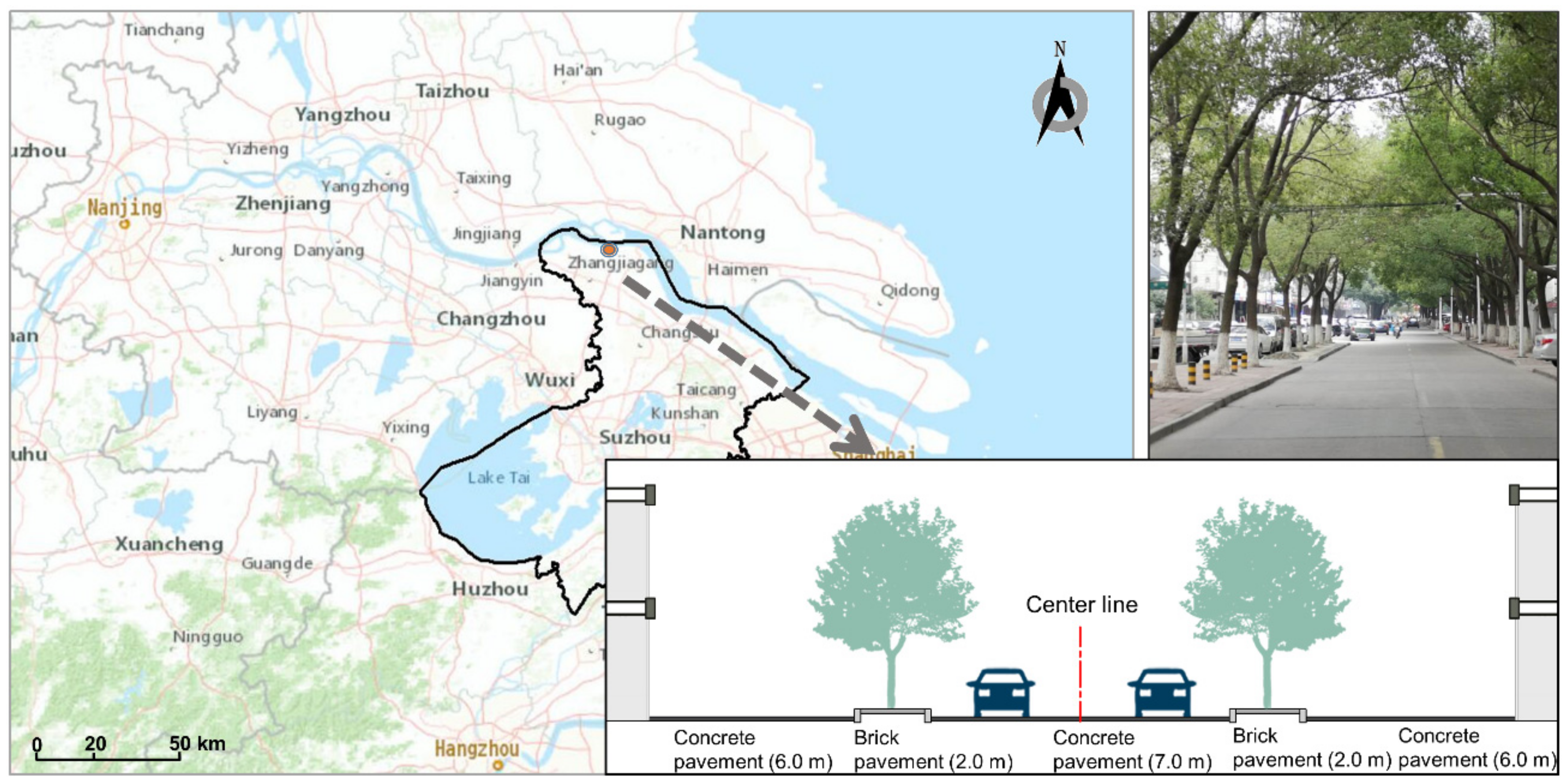
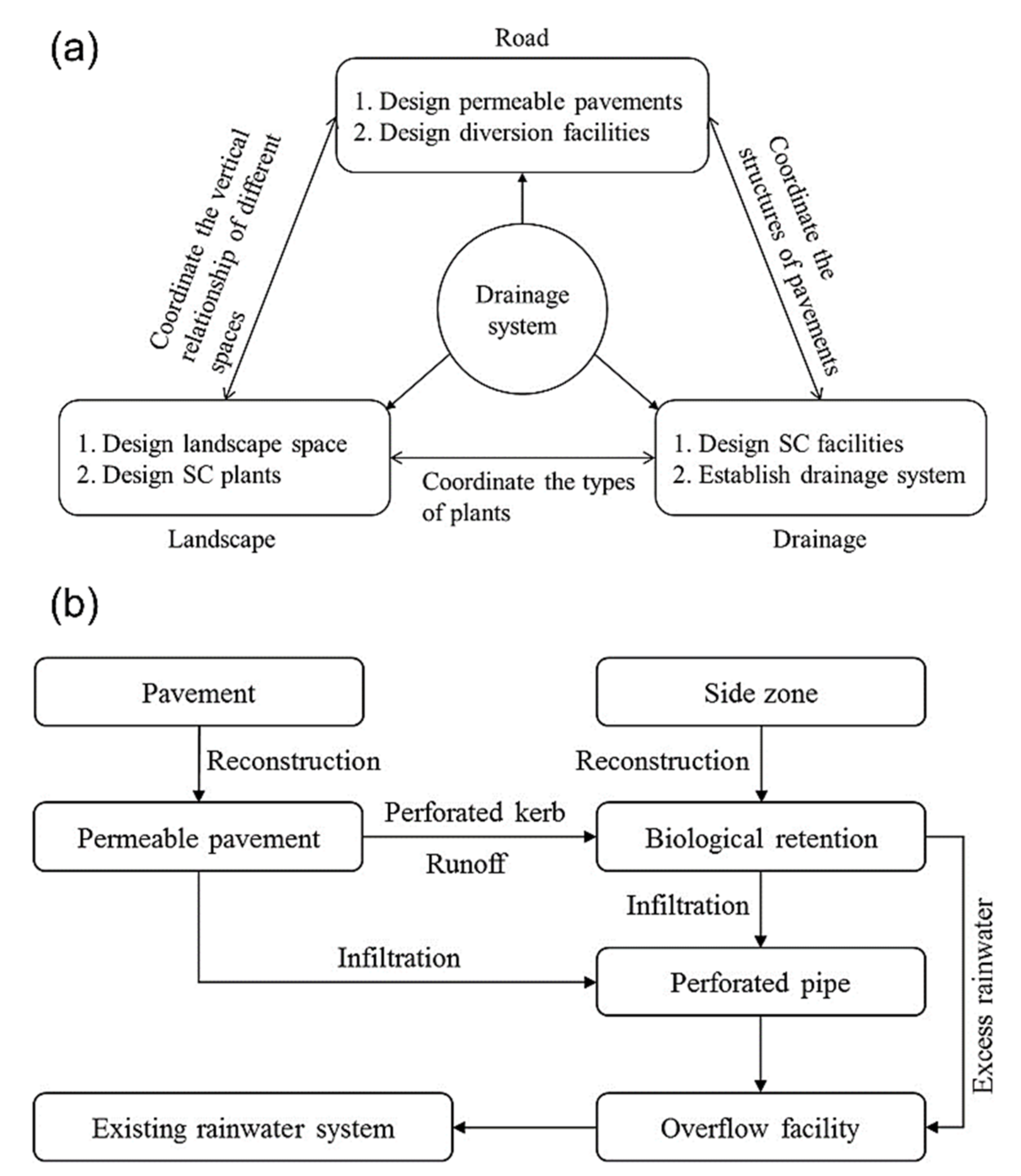

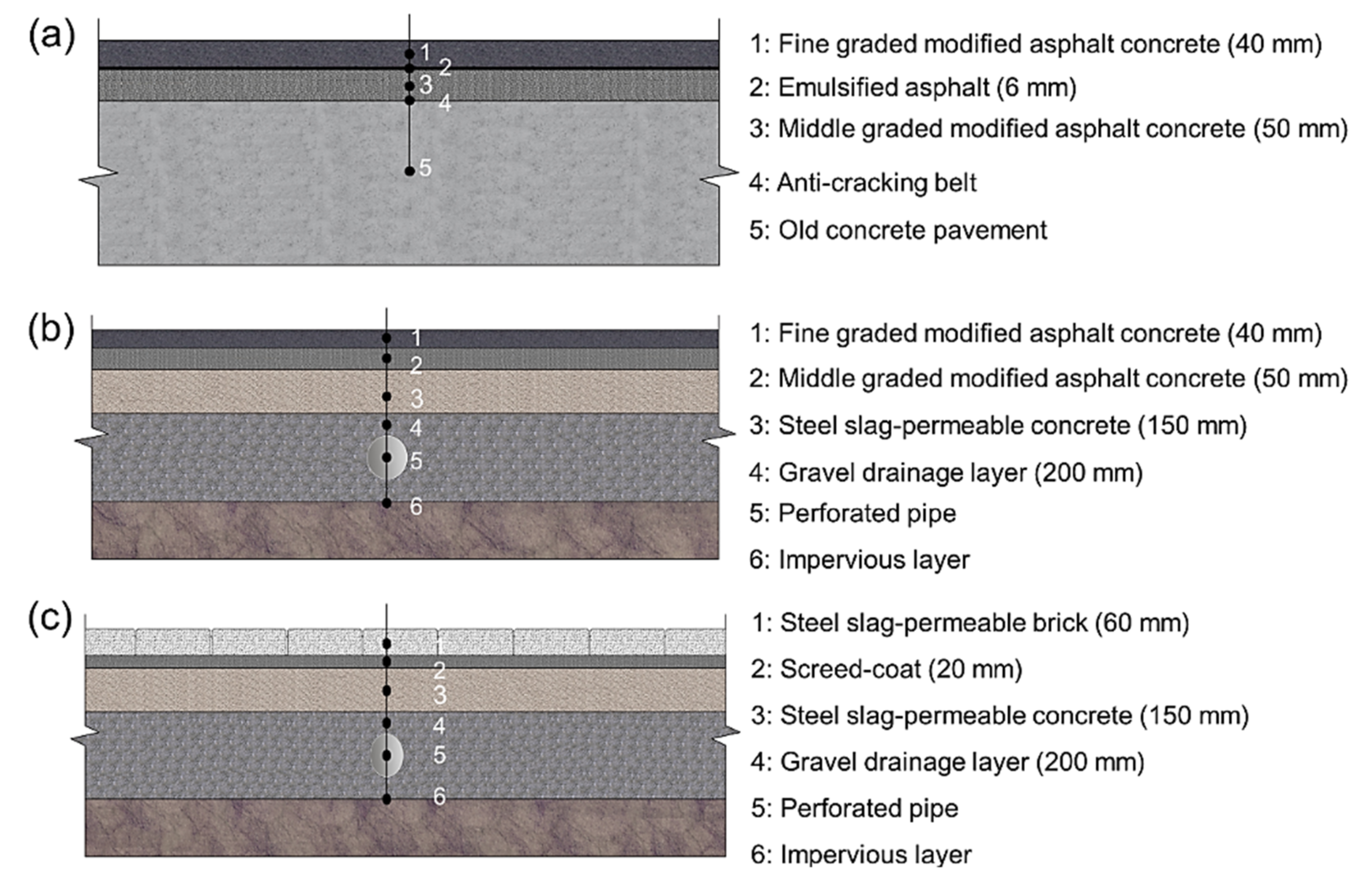
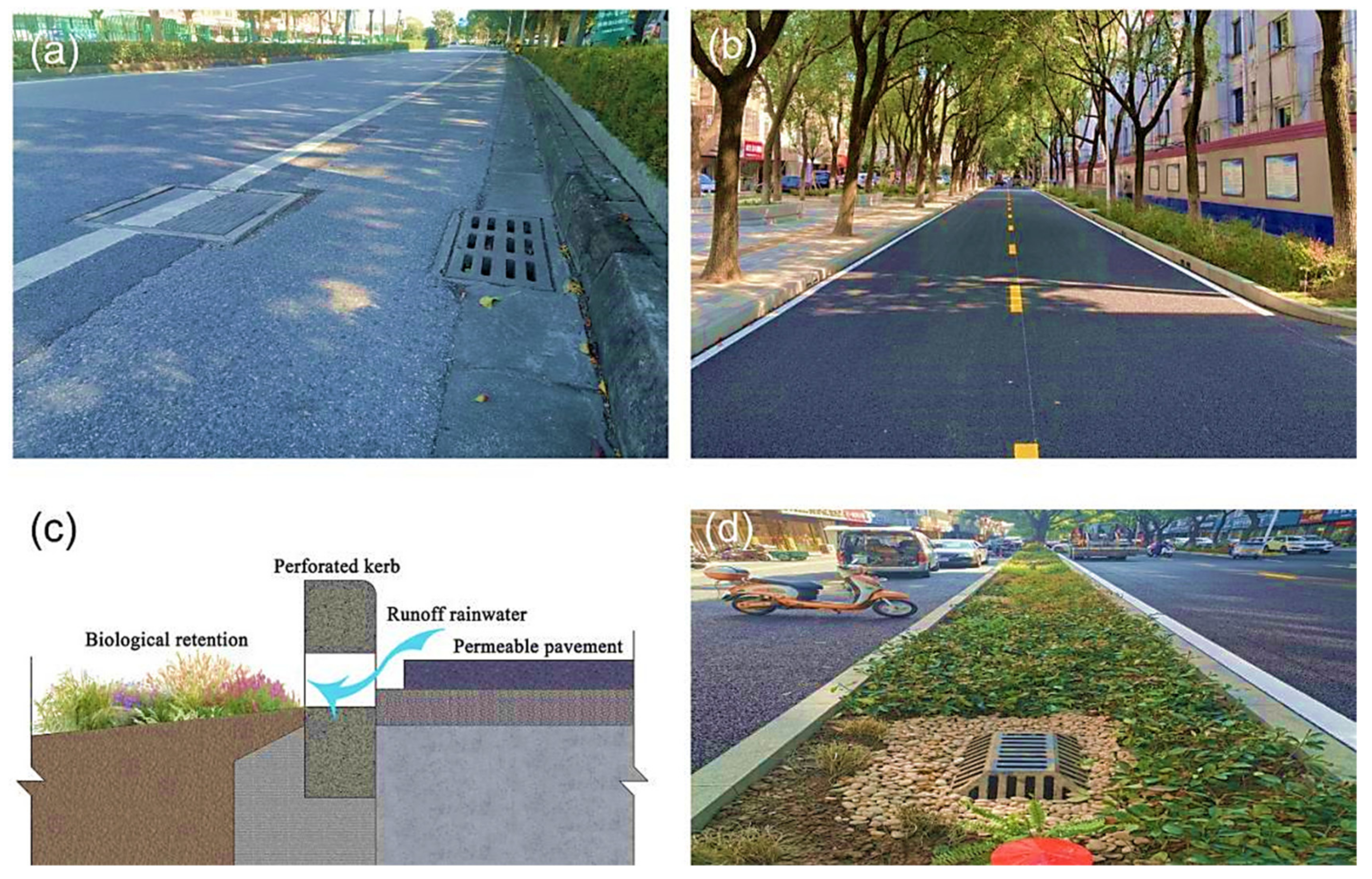
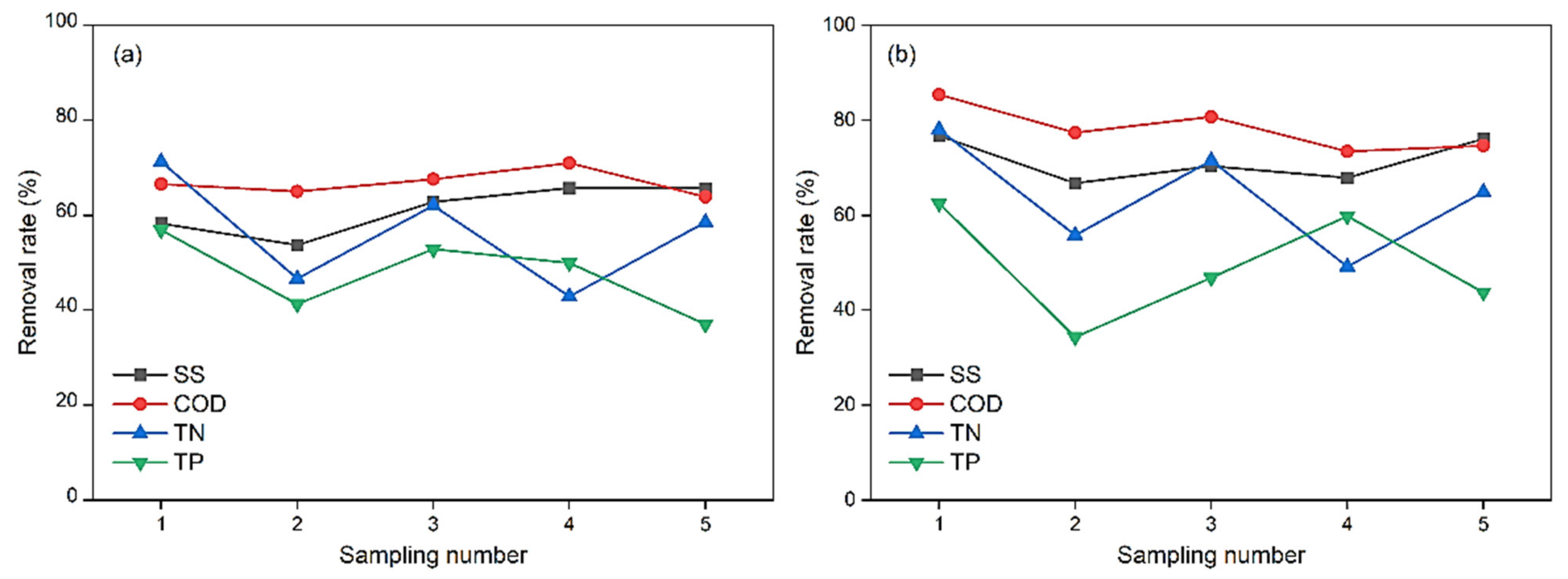
| Hot Material Warehouse (Size, mm). | Proportion (%) |
|---|---|
| 1# (0–3) | 11.5 |
| 2# (3–6) | 0 |
| 3# (6–11) | 49.0 |
| 4# (11–15) | 34.5 |
| Mineral powder | 5.0 |
| Diameter of Square-Opening Sieve (mm) | Mass Proportion of Sifting (%) | |
|---|---|---|
| Design Gradation | Design Standard | |
| 16 | 100 | 100 |
| 13.2 | 98.1 | 90–100 |
| 9.5 | 60.8 | 50–80 |
| 4.75 | 16.8 | 12–30 |
| 2.36 | 13.7 | 10–22 |
| 1.18 | 11.3 | 6–18 |
| 0.6 | 9.2 | 4–15 |
| 0.3 | 8.0 | 3–12 |
| 0.15 | 7.1 | 3–8 |
| 0.075 | 5.1 | 2–6 |
| Test Items | Detection Value | Technical Requirements |
|---|---|---|
| The number of actual hits of the Marshall specimen | 50 | - |
| Whetstone ratio (%) | 4.5 | - |
| Relative density of gross volume | 2.421 | Measured |
| Theoretical relative density | 3.036 | Calculation |
| Porosity (%) | 20.3 | 20–22 |
| Stability (KN) | 9.86 | ≥5.0 |
| Binder loss of Schellenberg asphalt leakage test (%) | 0.22 | ≤0.8 |
| Mixture loss of the Fort Kentucky flying test (%) | 7.0 | ≤15 |
| Mixture loss of the water immersion Kentburgh scattering test (%) | 14.6 | 20 |
| Residual stability in immersion Marshall test (%) | 92.8 | ≥85 |
| Permeability coefficient (mL/min) | 5433 | ≥5000 |
| Structural Layer | Minimum Permeability Coefficient K (m/s) | Minimum Void Ratio (%) | Material Specifications |
|---|---|---|---|
| Planting soil | 1.5 × 10−5 | 5 | Evenly mix 45% medium sand, 10% pine bark, 5% nutrient soil |
| Filter layer | 10 × 10−5 | 10 | Ceramsite matrix of φ 7–10 mm |
| Drainage layer | 100 × 10−5 | 15 | φ 20–30 mm gravel with perforated drainage pipe |
Publisher’s Note: MDPI stays neutral with regard to jurisdictional claims in published maps and institutional affiliations. |
© 2021 by the authors. Licensee MDPI, Basel, Switzerland. This article is an open access article distributed under the terms and conditions of the Creative Commons Attribution (CC BY) license (https://creativecommons.org/licenses/by/4.0/).
Share and Cite
Wei, C.; Wang, J.; Li, P.; Wu, B.; Liu, H.; Jiang, Y.; Huang, T. A New Strategy for Sponge City Construction of Urban Roads: Combining the Traditional Functions with Landscape and Drainage. Water 2021, 13, 3469. https://doi.org/10.3390/w13233469
Wei C, Wang J, Li P, Wu B, Liu H, Jiang Y, Huang T. A New Strategy for Sponge City Construction of Urban Roads: Combining the Traditional Functions with Landscape and Drainage. Water. 2021; 13(23):3469. https://doi.org/10.3390/w13233469
Chicago/Turabian StyleWei, Chengyao, Jin Wang, Peirong Li, Bingdang Wu, Hanhan Liu, Yongbo Jiang, and Tianyin Huang. 2021. "A New Strategy for Sponge City Construction of Urban Roads: Combining the Traditional Functions with Landscape and Drainage" Water 13, no. 23: 3469. https://doi.org/10.3390/w13233469





